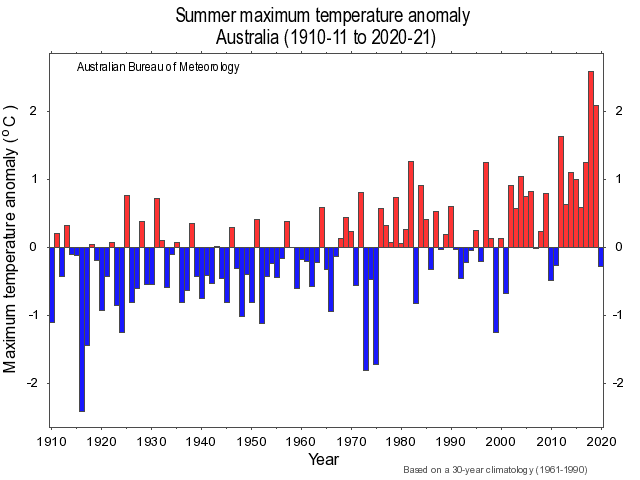The La Nina effect: Australia's coolest summer in nine years
La Niña just delivered Australia its wettest summer in four years and the first cooler-than-average summer in nine years based on daytime temperatures.
While some pockets of Australia were abnormally warm and dry in summer (looking at you Queensland), much of the country had a relatively wet and mild season.
Australia's national mean temperature during summer (December to February) was 0.06ºC above the 1961-1990 average. This was the country's coolest summer since 2012.
When looking at daytime warmth, Australia as a whole actually had a cooler-than-usual summer. The average national maximum temperature for the season was 0.28ºC below the 1961-1990 average. This was the country's first cooler-than-average summer (based on maximums) in nine years.

Image: Australia's summer maximum temperature anomalies since 1910. Red bars are summers that were warmer than the 1961-1990 average and blue bars were cooler-than-average summers. Source: Bureau of Meteorology
Rainfall was plentiful over much of Australia between December and February, with the country having its wettest summer in four years. For the Murray Darling Basin it was the wettest summer in a decade.
The healthy rain and mild temperatures of the past few months can both be credited to La Nina, which peaked in and persisted through the 2020/21 summer.
La Nina is an abnormal pattern of wind and sea surface temperatures in the equatorial Paficic Ocean that causes more moisture-laden air to flow towards Australia. La Niña typically enhances cloud cover and rainfall over large areas of Australia in summer, which promotes cooler days and warmer nights.

The cooling effect of La Niña, both in Australia and globally, can mask the background warming signal that's occurring as a result of contemporary climate change.
The footprint of La Niña can be seen clearly in the summertime temperatures of the last two decades. Only four out of the last 19 summers have featured below-average maximum temperatures in Australia. Unsurprisingly, these relative cool summers all occurred during La Niña events.